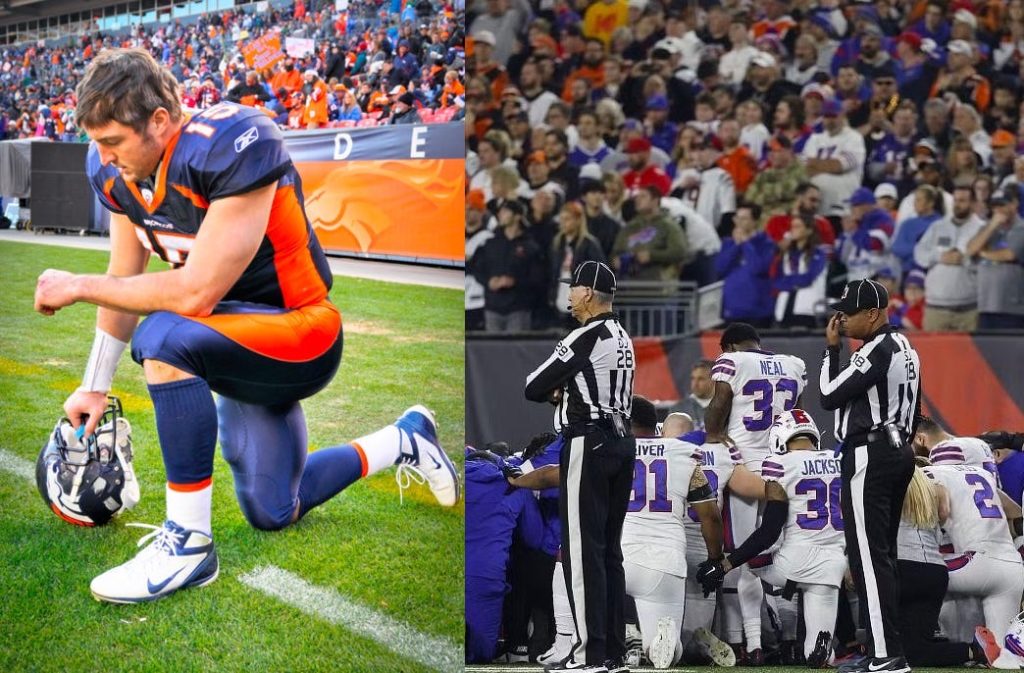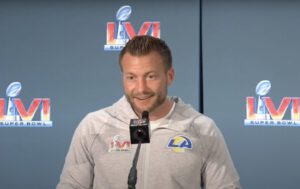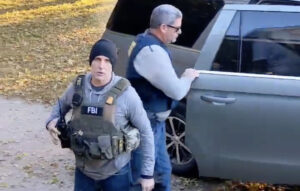When did prayer become acceptable to the NFL? When a crisis happened on live television
(Religion Unplugged) – Super Bowls create media storms, but many journalists and sports executives thought what happened in 1988 was totally out of bounds.
The establishment was shocked when…

(Religion Unplugged) – Super Bowls create media storms, but many journalists and sports executives thought what happened in 1988 was totally out of bounds.
The establishment was shocked when players and coaches from Denver and Washington, D.C., held a prayer meeting on the eve of this NFL rite. The powers that be worried that “fraternization” of this kind could damage this clash between gridiron warriors.
To make matters worse, players from competing teams soon began kneeling in post-game, on-field prayer huddles as a symbol of unity and, often, shared concerns about injured players. Players waved off league efforts to stop the prayer circles.
“For the NFL, this was a corporate thing,” said historian Paul Putz of Baylor University’s Faith and Sports Institute. Executives are “fine with prayer, as long as it isn’t tied to anything controversial or a specific brand of religion. …
“The NFL didn’t mind prayers that were out of sight, maybe in locker rooms with chaplains. But then things started happening on television. That was too much.”
That was then. The electric wave of prayer that swept America after Buffalo Bills safety Damar Hamlin’s heart-stopping injury was, he said, a “critical mass” moment and a sign of changing times — maybe.
The key was that this drama happened on “Monday Night Football,” with anguished players from both teams huddled around Hamlin near midfield, many visibly praying, as first responders fought to save his life.
It was natural for broadcasters to acknowledge the explosion of social-media commentary from athletes, coaches and others — including fervent calls for prayer. All 32 NFL teams soon posted #PrayForDamar appeals.
“We have never seen anything like this before,” said Putz. It became clear that it “was OK to tweet messages that went way beyond the usual thoughts and prayers.”
The question, added Putz, is what happens next. At some point, NFL leaders and the press need to accept that many players and coaches — in Black, White and interracial churches — are believers and that this affects their lives. The problem is that religion is a hot-button subject in American culture and politics.
The left was upset when Tim Tebow knelt in prayer, because of his traditional beliefs about marriage, sexuality and abortion. The right was upset when Colin Kaepernick, a former prayer-circle participant, linked kneeling during the national anthem with pleas for racial justice and police reform.
During the anxious days after Hamlin’s injury, and during his remarkable recovery, what mattered is that athletes took advantage of mass-media changes that allowed them to speak for themselves, said Putz. Twitter and Instagram were important, but it was also important that many former players play prominent roles in broadcasting.
In one symbolic moment, former NFL quarterback Dan Orlovsky cited a Buffalo Bills appeal for prayer and then lowered his head and prayed — live — on ESPN.
“God, we come to you in these moments that we don’t understand. … We’re sad, we’re angry and we want answers, but some things are unanswerable,” he said. “We just want to pray, truly come to you and pray for strength for Damar, for healing for Damar, for comfort for Damar. Be with his family to give them peace. … We believe in prayer.”
Life can change in the blink of an eye. Damar’s injury has made us all wrestle with this truth. It has served as a reminder of own mortality. While we pray for him as he fights for his life we must ask ourselves where will we spend eternity? Thanks for this convo @andersoncooper pic.twitter.com/WrYQWNZ4hR
— Benjamin Watson (@BenjaminSWatson) January 5, 2023
During a live CNN interview with Anderson Cooper, former NFL star Benjamin Watson stressed that players share a “brotherhood” in which they know injuries can end their careers and lives in a heartbeat. This raises unavoidable religious questions, he said.
“We all have a day to be born and we all have a day to die. So often, in between those two points, we feel invincible,” he said. Watching the Hamlin drama made “us realize — ‘Where are we?’ — that we’re all weak. Where do our hearts stand? … The questions about what happens after this life … they are coming up for all of us, not just for the football players.”
While many NFL leaders and journalists may try to ignore questions of this kind, it will be harder to do so in the future, according to Putz.
“We need more religion in our conversations about sports culture, not less,” he said. “There is true diversity in the many different religious perspectives found in the NFL. We need to listen to those voices, not fear them. There are religious questions here. Let’s talk about that and dig deeper.”



